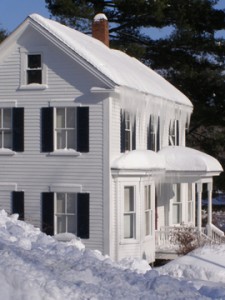
Freezing rain, ice, strong winds and dangerously low temperatures can cause lots of trouble in and around the house. Thus, if you intend to leave your home for warmer climates during the winter, it’s very important to know how to winterize your living space properly. In New England where the winters are long and bitter, it is best to start preparations during the fall season.
The most essential thing about winterizing is to help keep your home warm without turning up the heat. That’s important considering that your home will be vacant for several months. Before you leave, prepare your home with some of these tips:
Alternative Energy Technologies
Geothermal heating, solar panels, and wind turbines can help keep your home warm while saving a lot of energy. To prevent specific disasters related to frozen pipes and formation of ice dams on the roof, choose a minimum setting for your furnace thermostat.
Home Energy Audit
An audit can discover any leak, furnace, insulation and duct work issues, helping you determine where your house is losing energy.
Extra Insulation
If your home fails the energy audit, consider adding more insulation between the walls. Make sure you also cover the basement ceiling and attic floor properly. Various window insulation kits can boost your home’s ability to hold the heat inside. Pipe insulation is to prevent pipes from freezing and bursting. Burst pipes can be disastrous when temperatures rise. If pipes lack proper insulation, try using pre-slit polyethylene foam.
Energy Conservation
The easiest way to conserve energy is to seal ducts and dodge the drafts. According to the U.S. Department of Energy, up to 30% of energy use is wasted because of unsealed ducts and drafts. Using proper duct insulation and draft snakes can help you conserve energy.
Weather Stripping and Caulking
These two insulation options allow you to seal any gaps, which lower the energy efficiency index of your home. To discover these gaps, take a close look at places where two or more building materials meet, such as along the foundation and corners, where wires and pipes enter or exit the house, and around chimneys. Weatherize the doors and windows to minimize heat loss.
Furnace Maintenance
Although the furnace will not reach its maximum capacity during the winter, it’s essential to keep it lubricated, clean and properly adjusted if you wish to lower energy consumption. Choose a minimum setting for your thermostat to save more energy. Check filters and replace if needed.
Water
Prior to leaving your home, turn off the water and completely drain all the pipes. However, if you do not plan to drain the pipes, a constant trickle of water will help prevent pipes from freezing.
Home Heating
From an energy standpoint, keeping the heat on in a vacant home may seem wasteful but bringing the heat down to the Low setting will keep the pipes from bursting and prevent temperatures inside from freezing.
Good Neighbor Concierge House Sitting Service
Homeowners can avoid costly mistakes by adequately preparing their homes for cold winter weather, especially if their home will be vacant for long periods. In addition, the presence of a trustworthy house sitting service will ensure the safety and security of your home while you are away.





Connect With Me!